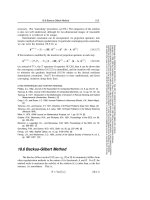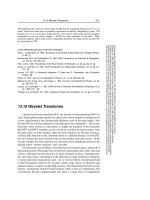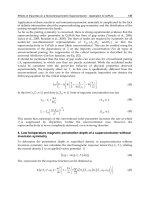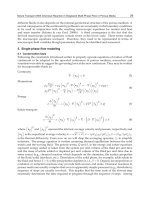Differential Equations and Their Applications Part 7 docx
Bạn đang xem bản rút gọn của tài liệu. Xem và tải ngay bản đầy đủ của tài liệu tại đây (605.89 KB, 20 trang )
110 Chapter 5. Linear, Degenerate BSPDEs
Theorem 2.3.
Let m > 1 and (H)m hold for
{A, B, a, b, c}.
Let (1.6) and
(2.2) hold. Let A > 0 such that
{ e-~(')f 9
L2~(O,T;Hm(]Rn)),
(2.14) e -~ (")g 9 L~r (ft; gm(Rn)).
Then
BSPDE (1.1) admits a unique adapted weak solution (u, q), such that
the
following
estimate
holds:
T
EHe-~()u(t,.)l]2H m +El He-~()q(t,.)ll2H.~-,dt
max
tE[0,T]
Jo
+ E E fr/{ ((A- BBr)D[O~(e-~(')u)],D[O~(e-~(')u)])
(2.15) [al_<m -Io JR ~"
+ BT{D[OC~(e-A(')u)]} + OC~(e-X(')q) 2}dxdt-
_<
+
where the constant C > 0 only depends on m, T and Kin.
Furthermore, if m > 2, the weak solution
(u,
q) becomes the unique
adapted strong solution of (1.1); and if m > 2 + n/2, then (u, q) is the
unique adapted classical solution of (1.1).
In the case that (2.2) is replaced by (2.6) or (2.7),
the
above conclusion
rema/ns
true and the estimate (2.15) can be improved to
the
following:
T
ElJe-~(')u(t,.)[[~m
+
E[
[le-~(')q(t,.)[[2H.~dt
max
t~[O,T]
Jo
/o'/o
(2.16)
+ ~ E . (AD[O~(e-~(')u)l,D[O~(e-~(')u)])dxdt
[aI<m
Finally, if in addition, (1.9) holds for some 5 > O, then (2.16) can further
be improved to the following:
max
Elle-~ <" >u(t,.)ll~m
te[O,Tl
(2.17) +E
{ lie-:' <" >u(t, ")115m+1
+lle-a(')q(t,')llhm}dt
Clearly, (2.14) means that f and g can have an exponential growth as
Ix I -+ ce. This is good enough for many applications.
w Uniqueness of adapted solutions
111
We note that
{A,B,a,b.c}
satisfies (H),~ if and only if
{A,B,~d,b,c}
satisfies (H),~, where ~ and b are given by (1.4). Thus, we have the exact
statements as Theorems 2.1, 2.2 and 2.3 for BSPDE (1.5) with a and b
replaced by ~ and b.
w Uniqueness of Adapted Solutions
In this section, we are going to establish the uniqueness of adapted weak,
strong and classical solutions to our BSPDEs. From the discussion right
before Proposition 1.3, we see that it suffices for us to prove the uniqueness
of adapted weak solutions.
w Uniqueness of adapted weak
solutions
For convenience, we denote
(3.1)
s ~ V.[ADu] + ( a, Du ) +cu,
3dq ~ V.[Bq] + ( b, q ) .
Then, equation (1.1) is the same as the following:
f du=-{s f}dt+(q, dW(t)), (t,x) 9215
'~,
(3.2)
U[t=T =
g.
In this section, we are going to prove the following result.
Theorem 3.1.
Let (2.3) hold and the following hold:
(3.3)
A 9 L~(O,T;L~176
BE L~/Oj:~, T', LO~/R,~.~ , ~n • d)),
a 9 Lcff(O,T;L~176
b 9 L~176176
c 9 L~(0, T; n~176
Then,
the
adapted weak solution (u, q) of (3.2) is unique in the class
(3.4)
u e Cf([0, T]; L2(a; H l(]Rn))),
q 9 L~=(0, T;
L2(Rn; Nd)).
To prove the above uniqueness theorem, we need some preliminaries.
First of all, let us recall the
Gelfand triple H 1 (~n) ~+ L 2 (~n) ~_+ H-1 (IRa).
Here, H-I(IR ~) is the dual space of Hl(~n), and the embeddings are
dense and continuous. We denote the duality paring between H 1 (]R n) and
H-I(~ '~) by (-,-)0, and the inner product and the norm in L2(IR ~) by
112 Chapter 5. Linear, Degenerate BSPDEs
(',')o and ]. [0, respectively. Then, by identifying L2(]R ~) with its dual
L 2 (R~)* (using Riesz representation theorem), we have the following:
( r ~ )o = (r ~)o
(3.5)
JR f" ~b(x)~o(x)dx,
Vr E L2(~Ln), ~ E
H'(]Rn),
and
(3.6)
n
i~lOir
E H-I(]Rn),
"~n
( Z o~r ~/o = -
i:1 ]R~
Vr E L2(IRn), 1 < i < n,
r
V99 E Hi(IRa).
Next, let
(u, q)
be an adapted weak solution of (3.2) satisfying (3.4).
Note that in (3.4), the integrability of (u, q) in x is required to be global.
By (3.5)-(3.6), we see that
(3.7)
s
+ A4q E L~(0,T; H-l(~n)).
In the present ease, from (1.15), for any ~ E HI(IR n) (not just
C~(Rn)),
we have
{d(u,~o)o=-(s
f,~)o+((q,~)o,dW(t)), tE[0, T],
(3.8) (u, ~)0
It=T = (g, ~)o.
Here,
(q, ~O)o ~((ql, ~)o,'", (qd,
~)0) and q = (ql,'",
qd).
Sometimes, we
say that (3.2) holds in H-I(IR '~) if (3.8) holds for all ~ E HI(Rn).
In proving the uniqueness of the adapted weak solutions, the following
special type of It6's formula is very crucial.
Lemma 3.2.
Let ~ E L2(O, T; H-I(~)) and (u, q) satisfy (3.4), such that
du=~dt+(q, dW(t)>,
tE[0, T].
(3.9)
Then
(3.10)
0 t
lu(t)l~ = lu(O)l~ + {2
(r + Iq(s)l~}ds
.//
+
2
((q(s),u(s))o,dW(s)),
t E [0, T].
Although the above seems to be a very special form of general It6's
formula, it is enough for our purpose. We note that the processes u, q and
take values in different sp aces H 1 (IR~), L 2 (iRa) and H - 1 (]R~), respectively.
This makes the proof of (3.10) a little nontrivial. We postpone the proof of
Lemma 3.2 to the next subsection.
w Uniqueness of adapted solutions 113
Proof of Theorem 3.1.
Let (u, q) be any adapted weak solution of (3.2)
with f and g being zero, such that (3.4) holds. We need to show that
(u, q) 0, which gives the uniqueness of adapted weak solution. Applying
Lemma 3.2, we have (note (3.7))
P
T
Elu(t)l 2 = E.L
{2
(s + .A4q(s), u(s) )0
-
Iq(s)12} ds
= E , { - ( ADu, Du ) + ( a,
D(u 2) ) +2eu 2
2 (q, BTDu)
+2
(bu, q) -]ql2}dxds
-
Iq + BTDu - bul 2
+ [b 2 + 2c - V-(a +
Bb)]u2}ds
/*
T
< C/ Elu(s)l~ds , t 9
[0, T].
Jt
By Gronwall's inequality, we obtain
El(t)l ~ = O,
t 9 [0, T].
Hence, u = 0. By (3.11) again, we must also have q = 0. This proves the
uniqueness of adapted weak solutions to (3.2). []
w An It5 formula
In this subsection, we are going to present a special type of It6's formula
in abstract spaces for which Lemma 3.2 is a special case.
Let V and H be two separable Hilbert spaces such that the embedding
V ~-+ H is dense and continuous. We identify H with its dual H' (by Riesz
representation theorem). The dual of V is denoted by V'. Then we have
the
Gelfand triple V r H = H' ~ + V'.
We denote the inner product and
the induced norm of H by (-, ")0 and [-10, respectively. The duality paring
between V and V' is denoted by (.,.)0, and the norms of V and V' are
denoted by 1]" I[ and I[" []*, respectively. We know that the following holds:
(3.12) (u,v)0=(u,v)o, VueH, v9
Due to this reason, H is usually called the
pivot space.
It is also known (see
[Lions]) that in the present setting, there exists a symmetric linear operator
A e s V'),
such that
(3.13)
(Av, v)o <-Hvll
2, VveV.
Now, let us state the following result which is more general than Lemma
3.2.
114
Lemma 3.3.
Let
(3.14)
satisfying
(3.15)
Then
Chapter 5. Linear, Degenerate BSPDEs
[
~
9 c~([0, T]; V),
9 L~(0, T; Y'),
du=~dt+(q, dW(t)), t9
~0 t
lu(t)[o ~ = lu(O)lo ~ + {2 (~(s),u(s))o + [q(S)lo~}ds
(3.16)
//
+ 2 ((q(s),u(s))o,aW(s)),
t 9
[0,T].
In the above,
q 9 L}(O, T; H) d
means that
q = (ql,'", qa)
with qi 9
L~-(0, T; H). In what follows, we will see the expression
q 9 L}(O, T; V) a
whose meaning is similar. Before giving a rigorous proof of the above result,
let us try to prove it in an obvious (naive) way. From (3.16), we see that
the trouble mainly comes from ( since it takes values in V'. Thus, it is
pretty natural that we should find a sequence (k 9
L~(O, T; H),
such that
(3.17) (k -+ (, in L~(0, T; V'), (k ~ oe),
and let
Uk
be defined by
// /o
(3.18) u~(t) = u(0) + (k
(s)ds + (q(s), dW(s)
), t 9 [0, r].
Since the processes
Uk, (k
and q are all taking values in H, we have
//
luk(t)[~
=
lu(0)10 ~ + {2 (Sk(S),Uk(S) )0
+ [q(s)12}ds
(3.19)
+2
((q(s),uk(s))o,dW(s)), t9
This can be proved by projecting (3.18) to finite dimensional spaces, using
usual ItS's formula, then pass to the limit. Having (3.19), one then hopes
to pass to the limit to obtain (3.16). This can be done provided one has
the following convergence:
Uk + U,
in L~:(0, T; V).
However, (3.17)-(3.18) only guarantees
Uk -+ u,
in L~:(0, T; Y').
Thus, the convergence of
Uk
to u is not
strong
enough and such an approach
does not work! In what follows, we will see that to prove (3.16), much more
has to be involved.
w Uniqueness of adapted solutions 115
Let us now state two standard lemmas for deterministic evolution equa-
tions whose proofs are omitted here (see Lions [1]).
Lemma 3.4. Let v : [0,
T] -+ V ~ be absolutely continuous, such that
(3.20) [ v 9 52(0, T; V),
(
b 9 L2(0, T; V').
Then v 9 C([O,T];H) and
(3.21)
d[v(t)to
2
=
2(9(t),v(t))o,
a.e.t 9 [0,T].
Let A 9 s V') be symmetric satisYying (3.13). Then for
(3.25)
Let
(3.26)
M(t) = fot
Then, M 9 Cj:([O,T]; V) and
v 9 L~(0, T;V),
~3 9 L2(0, T; V'),
q 9 L2~(O, T; V) d.
(q(s),dW(s) ), t 9 [0, T].
(3.27)
fot fo'
[M(t)l~ = 2
((M(s),q(s))o,dW(s) )
+ [q(s)l~ds,
t 9 [0, T], a.s.
Lemma 3.5.
any vo E H and
f E L2(0,T;
V'), the following problem
(3.22) ~7)=Av+f, tE[0,T],
I
v(0) = vo,
admits a unique solution v satisfying (3.20) and
/o' /o'
(3.23) Iv(t)lo 2 +
IIv(s)ll2ds <_
Ivolg +
I]f(s)ll2.ds, t e
[0,T].
Moreover, it holds
/o'
(3.24) Iv(t)lo 2 = Ivolo 2 + 2 (Av(s)
+ f(s), v(s) )ods, t 9
[0, r].
Now, we consider stochastic evolution equations. We first have the
following result.
Lemma 3.6.
Let v be an {Ft}t>_o-adapted V'-valued processes which is
absolutely continuous almost surely and q
be an
{ ~t }t>_o-adapted H-valued
process such that the following holds:
116
(3.28)
Chapter 5. Linear, Degenerate BSPDEs
d(v(t), M(t))o
= (O(t),
M(t) )odt + ((v(t), q(t))o, dW(t) ),
a.e. t E [0, T], a.s.
Proof.
First of all, it is clear that M E C~=([0, T]; V) and (3.27) holds
since we may regard both M and q as H-valued processes. We now prove
(3.28). Take a sequence of absolutely continuous processes
Vk
with the
following properties:
(3.29)
vk E L~(0, T;V),
Ok E L~-(0, T; H),
Vk + V,
in L~:(0, T; V),
Ok + 0, in L2(0, T; V').
Now, in H, we have (note (3.12))
(3.30)
d(vk
(t),
M(t))o = (Ok (t), M(t))odt + ((Vk (t), q(t))o, dW(t) )
= (0k (t),
M(t) )odt + ((Vk (t), q(t))o, dW(t) ).
Pass to the limit in the above, using (3.29), we obtain (3.28). []
Lemma 3.7. Let A E
s V')
be symmetric satisfying (3.13). Then, for
any f, q, u0 satisfying
(3.31)
f E L~(0, T;V'),
q E L2(0, T;
H) d,
u0 E H,
the following problem
S du = (Au + f)dt + (q, dW(t) },
(3.32)
[ =
t e [0, T],
admits a unique solution u E L2(0, T; V) M C7([0, T]; H), such that
(3.33)
~0 t
lu(t)J~ = luol~
+ {2
(Au(s) +
f(s),
u(s))o +
Jq(s)l~}ds
//
+ 2 ((q(s),
u(s))o, dW(s)
>, Vt E [O,T], a.s.
Proof.
We first let q E L~(0, T;
V) d
and define
M(t)
by (3.26). Con-
sider the following problem:
(3.34)
O=Av+f+AM,
t ~ [0,T],
v(0) = uo.
w Uniqueness of adapted solutions 117
By Lemma 3.5, for almost all w E ~, (3.34) admits a unique solution v.
Obviously (by the variation of constants formula, if necessary), v is {~t}t>o-
adapted. Thus, we have
e L~-(0, T, V'),
which implies (by Lemma 3.4) v C Cj:([0, T]; H) and (by (3.24))
(3.35)
Iv(t)t~ = lu~ + 2 (.Av(s) + f(s) +
.AM(s),
v(s) )ods,
Vt ~ [0, T], a.s.
Set
u(t) = v(t) + M(t).
Then, we see that u E g~(0, T; V) N C~-([0, T]; H)
is a solution of (3.32). We now combining (3.27)-(3.28) and (3.34) (3.35)
to obtain the following:
lu(t)]~ = Iv(t)l~ + IM(t)]~ +
2(v(t),
M(t))o
= luolo2 +2
(.Av(s)+f(s)+AM(s),v(s))ods
/0 /o
+2
((M(s),q(s))o,dW(s) ) + Iq(s)lgds
+ 2 (i~(s), M(s) )ods + 2 ((v(s), q(s))o, dW(s) )
(3.36) = 1~o1~+2
(Au(s)+S(s),v(s))odS
/o /o
+ 2 ((u(s), q(s))o, dW(s) ) +
Iq(s) lgds
+ 2 (Au(s) + f(s), M(s) )ods
= luolg + {2 (A~(s) + S(s),~(s))o + Iq(s)lg}ds
+2 ((~(s),q(s))o,aW(s)).
Next, we claim that solution to
(3.32)
is unique (for any f, q and uo sat-
isfying
(3.31)).
As a matter of fact, if ~ is another solution to (3.32), then
u - ~ is a solution of
(3.32)
with f, q and uo all being zero. Applying
(3.36)
to u - ~, we obtain (see
(3.13))
I~(t) - ~(t)lo ~ = 2 (A[~(s) - ~(s)], ~(s) - ~(s) )oas
___ 0,
which results in u = ~. Thus, we have proved our lemma for the case
q E L~(0, T;
V) d.
Now, for general case, i.e.,
q e L~(O, T; H) e,
we take a
118 Chapter 5. Linear, Degenerate BSPDEs
sequence
qk E
L2(0, T;
V) d
with
qk + q, in L~(0, T;
H) d.
Let
uk
be the solution of (3.32) with q being replaced by qk. Then applying
(3.36) to
Uk ue,
we have (note (3.13))
Eluk(t) - u,(t)l~ + 2El t
Iluk(s)
-
ut(s)ll2ds
(3.37)
dO
//
_< E Iqk(S)
q~(s)12 ds ~ O, k,e + oc.
This means that the sequence
{Uk}
is Cauchy in L2(0, T; V)AC~:([0, T]; H).
Hence, there exists a limit u of
{u}k
in this space. Clearly, u is a solution
of (3.32). Also, we have a similar equality (3.33) for each uk. Pass to the
limit, we obtain the equality (3.33) for u (with general q E L~(0, T;
H)d).
[]
Now, we are ready to prove Lemma 3.3.
Proof of Lemma 3.3.
Set
no = u(O) C H,
f ~= ~ - Au 9
L~(0, T; V').
Then u is a solution of (3.32) with (3.31) holds. Hence, (3.33) holds, which
yields (3.16). []
Now, by taking V = HI(R~), H = L2(R ~) and V' = H-I(IR~), we see
that Lemma 3.2 follows immediately from Lemma 3.3.
w Existence of Adapted Solutions
The proofs of existence of adapted solutions is based on the following fun-
damental lemma.
Lemma 4.1.
Let
the
parabolicity condition (1.6) and
the
symmetry con-
dition (2.2) hold. Let (H)m hold for
some m >_ 1. Then there exists a
" constant C > O, such that for any u G C~(]R n) and q E C~(~n;
]l~d), it
holds
(4.1)
{ ((A - BBT)D(O%),D(0%))
I~l<m
+lBTD(Oau)+OC~q]2} + E IOaql2} dx
I~1_<,~-1
I,~1<~
a.e. t ~ [O,T], a.s.
w Existence of adapted solutions 119
If (2.6) or (2.7) holds
instead
of
(2.2),
following:
(4.2)
the above can be replaced by the
/ {E
I~l_<m
<c/ E
( AD(Oau)'D(Oau))+ E
la<'ql2} dx
I~l_<m
{ - 2(a%)a"(s
+ Mq)+
la'ql 2 + la"ul2}d=,
a.e. t E [0, T], a.s.
Furthermore, if (2.6) or (2.7) holds and A( t, x) is uniformly positive definite,
then (4.2) can be improved to the following:
S { ) ]- la<'ul'+ ~ iraqi'}a,,
Io<l<m+l Io, l<m
(4.3) < C mR. E {-
2(oc~u)oc~(s +
Mq)+
1O"ql2 +
tO=ul2}dz,
I~l<m
a.e. t e [0, T], a.s.
We note that the square root of the left hand side of (4.1) is a norm
in the space C~(R n) • C~~ ]Rd). Thus, if we denote the completion of
the space
C~~ n) • C~(~n; ~d)
under this norm by
7-lm(tl w)
(note that
it depends on (t, w) E [0, T] • fl), then we have the following inclusions:
cF(~ n) • cF(n~; n ~) c u~(t,w) c_
H~(n n) • H~-I(~; ~).
It is clear that estimate (4.1) also holds for any (u,q) E 7/m(t,w). A similar
argument holds for (4.2) and (4.3).
Since the proof of the above lemma is rather technical and lengthy, we
postpone its proof to the next section.
Before going further, let us recall the following fact concerning the dif-
ferentiability of stochastic integrals with respect to the parameter. Let
h E L~(O, T; C~(Rn; ~d)).
Then it can be shown that the stochastic inte-
gral with parameter:
f~ ( h(s, x,
.),
dW(s) )
has a modification that belongs
to n~:(0, T; c~-l(~n; lRm)) and it satisfies
f
' x, f[
On .In ( h(s,
.),
dW(s) ) = ( O~h(s, x, .), dW(s) ),
(4.4)
for [a 1=l,2, ,m-1.
Consequently, if h C L2(0, T; C~), then
L
" ( h(s,
.),
dW(s) ) e L~(O, T; C~),
0 ~
and (4.4) holds for all multi-index a.
120 Chapter 5. Linear, Degenerate BSPDEs
In the rest of this section, we prove the existence of adapted weak
solutions to (1.1) (or equivalently (3.2)) under conditions of Theorems 2.1
or 2.2.
We first assume that conditions of Theorem 2.1 hold.
Let us take an orthonormal basis {~k}k_>l C_
C~(IR n)
for the Hilbert
space
H m =
Hm(lRn), whose inner product is denoted by
(~,r
- f_ ~
(a~)(a~r
v~,r 9
H m.
J.<
I~l<m
The induced norm is denoted by I" I-~. When
q = (ql,'",qd), P =
(Pl,"" ,Pd)9 (gm) d,
we denote
d
(q,p)~ = Z(q~,p~)m,
i=1
which should not be misunderstood from the context. As a usual conven-
tion, H ~ L2(IRn). Let k > 1 be fixed. Consider the following linear
BSDE (not BSPDE):
i k s u ki t ki t
dukJ(t)={ Z[( ~,~j)m () ((M~i,~j)m,q ())]
i=1
(4.5) - (f, ~j).~ }dt
+ ( qkj (t), dW (t) ),
(ukJ(T) = (g,(Pj)m, 1 <_ j <_ k.
By the result of Chapter 1, we know that there exists a unique adapted
solution
( uk"(.) 9 C~([0, T]; ~),
(4.6)
/
qkj(.) e L~(O,T;~d), l < j < k.
We define
u~
(t, x, co) = ~ ~kJ (t, co)~j (x),
(4.7) j=l (t,~,co) 9 [0,T] x a n • a.
k
qk(t,x, co) E qkJ(t, co)cpj(X),
j=l
Then we see that for any fixed (t, co) 9 [0, T] • f~,
uk(t, . ,co) 9 C~(Nn), qk(t,.,co) 9
C~(Nn;IRa).
Also, the following holds:
(4.8)
~ duk = { Pk[s
+ 34qk] fk}dt+
(qk'dW(t))'
(
uklt=T ~ gk
w Existence of adapted solutions 121
where
Pk : H m -+ span { qol ,
" , ~k } A H m
" " ~ k '
is the orthogonal projection (in
Hm),
and
/k = Pkf, gk = Pkg.
Note that, as processes,
u k
and qk, , q) are taking values in H~, where
qk = (qk, , qk).
Thus, in particular,
(4.9)
Pku k = u k, k >_ 1.
Next, we want to derive a proper estimate for
(u k,
qk).
By Lemma 4.1, we
have the following:
(4.10)
s { ~ { ((A-
BBr)D(O~uk),D(OC~uk))
+lBTD(O~uk)+O~qkl2}+ ~_, IO"qkl2} dz
I,~l_<m-x
I~[<m
+ IO"uk[2}dx.
On the other hand, applying It6-Ventzel'sformulato
[Oauk]2, we
have from
(4.8) that
(4.11)
E/la~ i~l_<m
T
= fL
~_, {lO~gk(x)l 2 -[O~uk(t,x)12}dx
~_, {2(o=uk)o ~ [Pk ( - s k - Mq k) - fk]
Icd<m
+ [OC~qkl2}dxds
T
= E { 2(uk,Pk(s + fl/lqk) + fk)m + lqkl2m}ds
(
= E { - 2(Uk,s k + Mq k + fk)m + [qkl2 m}ds
(s
: E o Z { - 2(O~uk)O"( c~k + Mqk)
I-I<m
+ [O~qkl2 - 2(O~uk)(o~fk)}dxds.
The third equality in above is due to (4.9). Then combining (4.10)-(4.11),
122 Chapter 5. Linear, Degenerate BSPDEs
we obtain
LI
(4.12)
{ ((A - BBT)D(O~uk), D(O~u k) )
I~l<m
+]BTD(O~uk)+O~qk]2}+ ~_,
IO~qkl'}'dx
I~l<_m-1
<_ C{Elgkll - Eluk(t)l~
l~l<m
By Gronwall's inequality, we obtain
T
max Eluk(t)12m + E f Iqk(t)12_ldt
te[0,T]
J0
+ z
s
(4.13) 1-1_ <m
+ BT[D(O~uk)] + O~q k 2}dxdt
fo k 2 Igkl:}.
<CE{
rlf (t)lm+
Note that the constant C > 0 in (4.13) only depends on T, m and
Kin.
From (4.13), we may assume that
(4.14)
{ u~ ~ u, weak* in L~(O,T;L~(ft;Ht)),
0<t<m,
qk __+ q,
weakly in L~(0, T;
Ht) d, 0 < ~ < m -
1,
and for any
lal <
m,
(4.15)
(A -
BBT)I/2D(Oe'u k) + (A - BBT)U2D(Oau),
BT[D(O~uk)] + O~q k ~ BT[D(O~u)] + O~q,
weakly in L2(0, T; H~
By taking limits in (4.13), we see that (u,q) satisfies the estimate (2.4)
with the constant C > 0 only depending on T, m and
Km.
We are going
to prove that (u, q) is a weak solution of (3.2). To this end, let us take
p E H 1 (0, T) such that
(4.16)
p(0)=0,
p(T)= l,
O<p(t)
< 1, tE[O,T].
w Existence of adapted solutions 123
Let ~ > 0 be fixed and k _ ~. For any ~ E H~ C C~(]Rn), from (4.8) and
the fact Pk~o = ~, we have
(gk, (fl) m = ~0 T {P(t)(uk(t), ~O)m
(4.17)
- p(t)(s + Mqk(t) + fk(t),~o),~}dt
T
+ fo p(t) ((qk (t), qo)m, dW(t)).
By the definition of/~ and Ad, using integration by parts, we obtain
(gk,~)m : ~0 T {P(t)(uk(t),~)m
-
p(t)[ -
l(A(t)Duk(t) + B(t)qk(t), D~o),~
(4.18)
+ ((a(t),
Duk(t) ) +c(t)uk(t) + (b(t), qk(t) ) +fk(t),
~O)m]
}dt
+ p(t) ((qk
(t),
~)m, dW(t) I, a.s.
If we denote
I
F(x, w) = g - .s {P(t)uk(t) _
p(t) [ (a(t),
Duk(t) ) +c(t)uk(t)
(4.19)
+ (b(t), qk(t) ) + fk(t)] }dt- ~0 T ( p(t)q k (t), dW(t) ),
T 1
G(x,w) = ~o P(t)[-2A(t)Duk(t) + B(t)qk(t)]dt'
then (4.18) reads
(4.20) (F, ~)m = (a, D~)m,
By the lemma below, we must have
(4.21) (F, ~)o = (G, D~p)o,
This tells us that
V~ e CF(Rn), a.s.
v~ ~ C~(R"),
a.s.
(gk,~)o = fo T {P(t)(uk(t),~)O
(4.22)
p(t) ( s k (t) + Mqk(t) + fk (t), ~ )o }dt
P
T
+ Jo p(t)((qk(t),~)o,dW(t)),
a.s.
We want to pass to the limit in (4.22) to obtain a similar equality for (u, q).
By (4.14) with g = 1 for u k and t = 0 for qa, together with the convergence
124
Chapter 5. Linear, Degenerate BSPDEs
of
(fk,gk)
to (f,g), we can pass to the limit in (4.22) weakly in
L2(~)
for
all terms except the last term which is involving the It6 integral. To treat
this last term, we define K : L~(0, T;
H~ d -~
L2(~) by
~0 T
EIKpl 2 = E Ip(t)(p(t), ~)ol2dt
(4.24)
< I~I~E Ip(t)l~dt, Vp E L2(O,T;H~ d.
This means that K is a bounded linear operator. Thus, for any T]C L2(~),
one has
(4.25)
E(~ fo Tp(t) ((qk(t) - q(t)'~)~ } )
= (7, K(q k - q))L2(n) = (K*~, qk
_
q)L2(O,T;HO) d ~
O.
Thus, we obtain
/0
= {p(t)
~)o
(4.26)
- p(t) ( s + A/~q(t) + f(t), ~ )o }dt
+ p(t) ((q(t), ~o)o, dW(t) ),
a.s.
Now, fixed any t E (0, T). For any e > 0, we let
0, s < t-e/2,
1 s t
(4.27)
p~(s) = ~+ T , t-c/2<s<t+z/2,
1,
s > t+6/2.
Choosing p = p~ in (4.26) and letting c + 0, we obtain
(g, ~)o =
(u(t), ~)o - ( s + 2r + f(t), ~)odt
(4.28)
+ ((q(t),~p)o,dW(t)),
V~peC~(l~n), a.s.
This means that (u, q) is an adapted weak solution of (3.2). By Theorem
3.2, it is unique.
In the case that m > 2, from (2.4), we see that (1.13) holds and thus,
by Proposition 1.3, (u, q) is an adapted strong solution (3.2). In the case
m > 2 + n/2,
by Sobolev's embedding theorem, (1.11) holds and therefore,
(u, q) is an adapted classical solution of
(3.2)
by Proposition 1.3 again.
~0 T
(4.23)
Kp = p(t) ((p(t), ~)o, dW(t) ), Vp e L~(O, T; H~ d.
Then
w Existence of adapted solutions 125
Finally, let us look at the case when conditions of Theorem 2.2 hold.
Suppose (2.6) or (2.7) holds instead of (2.2). By Lemma 4.1, we still have
(4.1), which is now equivalent to (4.2). Then all the proof that we have
presented above remains true. Moreover, we have estimate (2.8). In the
case that A is uniformly positive definite, a little more careful estimate leads
to (2.9). In fact, for the present case, in (4.12), we can use integration by
parts to get
(4.29)
E'~Km /T /R" 2(Oauk)(o~ fk)dxds
T
Jt
We leave the details of the proof to the interested readers. []
We now prove the following lemma which has been used in the above
proof.
Lemma 4.2.
Let F
E
H'~(]R '~) and G E Hm(]Rn) n, such that
(F,!P)m = (C,D~)m,
Vcp
E C~~
(4.30)
Then
(4.31)
(F,v)0 = (a,D~)0, V~ e C3~
Proof.
Let
S~S(]R n)
be the set of all ~ E C~176 such that
(4.32) ~,~(~o) ~ sup
Ix~O~(x)l < oo, Va,/~.
x ER '~
Under the family of semi-norms ~,Z, S is a Fr~chet space. Also, C~ ~ (Rn) is
a dense subset of S. Thus, (4.30) holds for all ~ E S. Next, by HSrmander
[1, p.161], Fourier transformation ~ ~ ~ is an isomorphism of S onto itself.
Applying Parseval's formula to (4.30), we obtain
(4.33) UR, [F(~)-(0(~),~)]( E 1~12) ~(~)d~=0' V~ECr(~n)"
I~l<m
Now, for any r e C~(~n), we have r ICI~) -1 c S. Thus,
there exists a ~o E S, such that
(4 4) Z -1
I~l<m
Combining (4.33) and (4.34), using Parseval's formula again, we obtain
(F,C)m = (G,Dr Vr E C~(~).
This proves our lemma. []
126 Chapter 5. Linear, Degenerate BSPDEs
w A Proof of the Fundamental Lemma
In this section, we are going to prove Lemma 4.1, which has played an
essential role in the proof of well-posedness theorems for (1.1).
Proof of Lemma ~.1.
Let g~lc~l _< m. For any u E C~(~ n) and
q E C~~ IRa), by definition of s and AA, and differentiation, we have
Z~A= Sn. { - 2(OC~u)O'~(s + Mq) + [OC'q[2} dx
+ V'[Bql+(b,q)]+[O'~ql2}dx
=/n" {- 2(O~u) [~
V'[AD(Oau)] + (a'D(O~u))+c(OC~u)
(5.1)
+ V.[B(O"q)] + ( b, Oaq ) ]
+
0<_/3<~
+ ( cOc~-Za, D(O~u) ) +(Oc~-Zc)(O/3u)
+ v.[(m-~B)(O~q)] + (m-~b,O~q)
}] }a~
where C~t~ is a positive integer depending on a and/3, and
I~ = ia" {- 2(0"u)[21 V'[AD(0<~u)] + ( a, D(0<~u) ) +c(0%s)
(5))
+ V.[B(O'~q)J+(b,O"q)] +lO"@}d:c,
(5.3)
o<~<a
+ ( O~-Za, D(OZu) ) + (O~-~c)(O~u) + O~-db, OZq) ] dz,
(5.4)
E
o_<~<~
I~1<1~1-1
CaB (0 au) V.[(Oa-ZB)(O/~q)]dx,
(5.5) :Z~ 2S~ E
Caz(Oau) V'[(Oa-~B)(O~q)]d'T'"
o_<f~<~
It~l=l~l-1
We note that in the case g = 0, Z~, Z~ and Z~ are all absent. We now treat
Z~, Z~, Z~ and Z~, separately.
w A proof of the fundamental lemma 127
Since A and B are C~ +1 in x, we see immediately that
2
(5.6) ]Z~'t + IZ~] -< C(tu]~ +
)qle-z)-
Now, let us look at Z~ and Z~'. Using integration by parts, we have
(5.7)
Z~ = fa" { (AD(O(~u)'D(O'~u))+2(O'~q'BTD(O~u))+lO'~ql2
- ( a, n[(O"u)2]) -2c(O"u) 2 - 2 (b(O'~u), O"q ) }dx
9 /R" { ((A- BBT)D(Oau),D(a~u))+[BTD(cO'~u)[ 2
+ [a~q[ 2
+ 2 ( O'~q, BTD(OC~u) ) -2 (b(Oau), cgaq )
- 2 ( BTD (O"u), b(O c~u) ) +IV. (a - Bb) -
2c] (0%)2
}
dx.
In the meantime, let us look at each term in Z~. For l~ < (t with I/~l = la[-1,
using integration by parts, we have
(5.8)
-
s (0%) v.[(a~-eB)(Oeq)]&
=/a,~ (Ozu) V.{O~-f~[(O~-f~B)(cOf~ q)]}dx
= -/R" (D(O~u)' (O~-~B)O~q + (cO2(e'-~)B)Ol3q) dx
=- f,, [((O~-eBr)D(Oe~), a"q ) + (D(Oeu), (O2(~-e) B)cO~q) )]dx.
Thus, it follows that
(5.9)
~ + I~ = /R ~ {((A-BBT)D(O~u),D(Oau)I
+ BTD(O~u) + O~q - b(O'~u) - E C~(O"-~BT)D(O~u)2
I~l=l,~l-z
-Ib(a%)l~-I
z
Cc~f~(O'~-ZBT)V(O/3u)2
o_<~<~
C,~e ((O"-OBT)D(Oeu), BT D(O%) )
+2E
0<~<~
I,OI=I~I Z
- 2 ~ c.~ <(O~-~B~)D(O~,~),b(O%) >
O<_f~<~
If~l=l~l 1
+ [V-(a -
Bb) - 2c](O"u) 2
- 2 Z c,~ <V(ae~),
(02(~
0<~<~
128 Chapter 5. Linear, Degenerate BSPDEs
Note that
(5.10)
/R ~ BTD(O~u) + O~q- b(O~u)
- E C~(O~-ZBT)D(OZu) 2dx
o_</~<a
Ifli=l~l-1
>__ 1 s BTD(OC, u ) +C3c~q 2dx
1
2/R~ b(O~u) +o<_~<~ C~(o~-zBT)D(Ozu) 2dx
I~l=lc, l-1
1
> -~/R ~ BTD(O~u) + OC~q 2dx -
Clul~.
Next, by the symmetry condition (2.2), for/3 < c~,
1/31 = I~1
- 1, we have
(5.11)
r~
((a"-~ Br)D(aZu)'
BT D(a~u) ) dx
= J'R~ ((BOa-~BT)D(OZu)' D(O~u) ) dx
= s 89 [o~-~ ((Bo~-~Br)D(a~),D(a~) )
- (O~-Z(BO~-eBT)D(O~u), D(OZu) ) ] dx
= _ 12/R~ ( Oa-~(BO(~-~BT)D(O~u)' D(O~u) ) dx _> -C]ul 2.
Combining (5.6), (5.9)-(5.11) yields
(5.12)
z ~ = z$ +z{~ +z~ +z$
> fR ~ { ((A - BBT)D(O~u),D(O~u))
+ ~IB TD(Oau) + OC~q[2 }dx - C(lul~ + [ql~-l).
Now, we sum (5.12) up for all lal < g to get the following:
(5.13)
s
->2[1 ~<~_/R" {((A-
BBT)D(O~u),D(O~u))
+ IBTD(O ~u) + OC*q[2} dx - C(lul 2 + Iq{~-l).
w A proof of the fundamental lemma 129
Thus, it follows that
~,~ E s
{ ((A- Br
I,~1<~
(5.14)
+ [BTD(0%) + a~ql2}dx
C (lll~g. -~ I11,12 "t- Iql2_1).
<
Note that
(5.15)
IO'~ql 2 <__ 21BTD(O~u) + OC'ql 2 + 21BTD(a~u)l 2.
Using the parabolicity condition (1.6) and the definition of Ot (see (5.14)),
we have
(5.16)
IqlLl
~
C((]}/-1
-1-lull).
Consequently, from (5.14), we obtain
U 2
(5.17) ~s ~ C(~s ~- (]}~-1 ~- I It), 1 < ~ < m.
On the other hand, for g = 0 (i.e., a = 0), we have
JR- {- 2u(s + .Mq) + Iql2}dx
:
i,.
{-'~
+ ~a, ~u~ +
+ V.[Bq] +
(b,q}]
+
Iql'}dx
(5.18) = i,~- {((A-BBT)Du,
Du)+IBTDul 2 +lql 2
+ 2 {q, BTDu)-2 (bu, q)
- 2 ( BTDu, by
} +[V.(a -
Bb) - 2c]u 2 }dx
k SRo
{((A-
BBT)D.,Du>+IBTD.+ql2ax CM~.
This implies
~5,9/ Oo_</~.
{-,.~§
Mq~ + Iql'} + clol~
Hence, it follows from (5.17) and (5.19) that
U 2
(5.20) ~ < c(~m +l Ira),
which is the same as (4.1).









